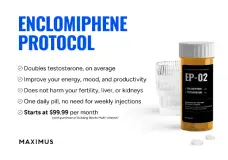Hi,
My labs just came back and surprise, I have high HCT 57.5 and low iron 8.5 umol/l from donating. Can someone explain to my why this can't be fixed with iron supplementation? Seems like the only thing that works is lowering your T dose. I'm only at 60mg twice a week. I feel no side effects, feel great actually but I don't want to die from heart disease.
Made a big mistake here getting caught up on that donating blood too often merry go round to control your elevated hematocrit as it is a given you will crash your iron/ferritin which can open up another can of worms.
Where did your baseline HCT sit pre-TTh?
Most men struggling with elevated RBCs, H/H is because they are running too high a trough/steady-state FT.
Would not get to caught up on the I am only at 60 mg 2x/week (120 mg) as one can easily hit a healthy let alone high trough FT on such dose.
Need to post your labs so we know where your trough TT and more importantly trough FT sits!
Throw SHBG in there too.
Most men on therapy are injecting 100-200 mg T/week whether once weekly or split into more frequent injections as in twice-weekly (every 3.5 days), M/W/F, EOD or daily.
As I have stated numerous times on the forum over the years most men can easily hit a healthy let alone high trough FT injecting 100-150 mg/week especially when split into more frequent injections.
Yes there will always be those outliers who may need the higher-end dose 200 mg/week but it is far from common as in rare!
Such dose would have the majority OVERMEDICATED!
Also keep in mind that some men can still achieve a stellar trough FT injecting <100 mg/week.
It is easy to raise your ferritin/iron through diet or supplementation but it will not do you any favours when it comes to lowering your hematocrit.
Lowering your trough/steady-state FT would be key here let alone addresisng any other factors which can contribute to such!
Other factors such as sleep apnea, smoking, asthma, COPD can have a negative impact on hematocrit.
Throw in making sure you are well hydrated (fluids/electrolytes) days before not just the day of getting blood work done otherwise it can skew the results and you will have no idea where it truly sits.
If your results. are accurate then you need to address this as the cutoff is 55% in Canada and even then most in the know would take measures once you hit 54-55% let alone some will not want it to venture beyond 50-52%.
Briefing Document: Optimizing Hematocrit Control in Testosterone Therapy
Source: Excerpts from "From Phlebotomy to Formulation: Optimizing Hematocrit Control in Testosterone Therapy -
Excel Male TRT Forum"
1. Executive Summary
Testosterone Replacement Therapy (TRT) offers significant benefits for hypogonadal men, including improved body composition, metabolic function, and mental well-being. However, a notable side effect is the increase in hematocrit (HCT) and hemoglobin levels, driven by testosterone's stimulation of erythropoiesis. Elevated hematocrit...














